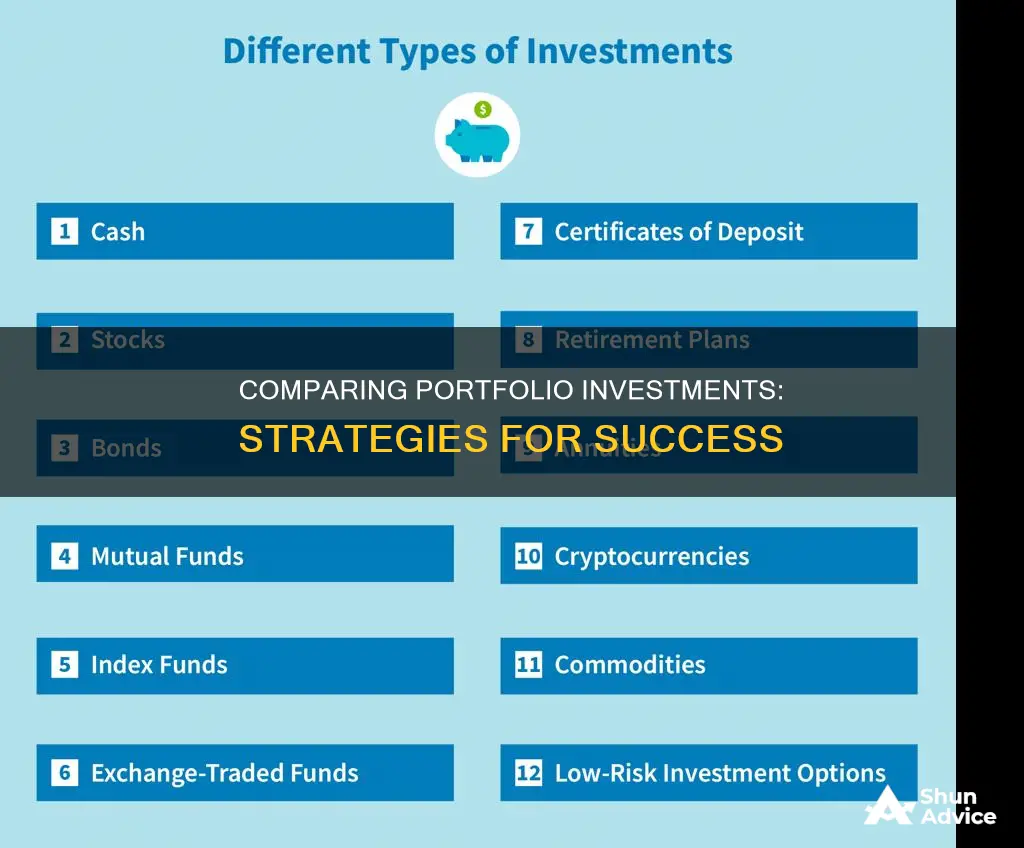
Comparing individual investments in a portfolio is a complex but essential task for any investor. It involves evaluating the performance of each asset to understand its individual contribution to the overall portfolio's success. This process requires analysing various factors, including returns, risk, fees, and market conditions.
One common approach is to calculate the Return on Investment (ROI) for each investment by comparing its current and initial values while considering factors such as dividends, interest, and trading commissions. This calculation provides insight into the individual performance of each asset, helping investors identify profitable or underperforming investments.
Additionally, investors can utilise benchmarks, such as broad indexes like the S&P 500, Dow Jones Industrial Average, or Nasdaq 100, to gauge their performance relative to the market. However, it is crucial to select a benchmark with a similar risk-return profile to the portfolio to ensure accurate comparisons.
Other methods for evaluating individual investments include the Treynor, Sharpe, and Jensen ratios, which combine risk and return performance into a single value, providing a more comprehensive assessment of the portfolio's overall health.
By regularly comparing individual investments, investors can make informed decisions about adjusting their portfolio, such as diversifying assets, changing investment strategies, or exploring different markets.
| Characteristics | Values |
|---|---|
| Compare to financial plan | Is the portfolio generating the returns needed to help achieve/maintain the desired lifestyle? |
| Compare to inflation | Can I buy at least the same in the future with my money or more? |
| Compare to peers | Are there alternative options that could be considered? |
| Time-weighted returns | Evaluate the performance of your portfolio, focusing on the portfolio's investment performance |
| Money-weighted returns | Account for the timing and size of an investor's contributions and withdrawals |
| Holding period return | A snapshot of your returns from holding a portfolio over a period |
| Annualized returns | Convert multi-period returns into a standardized yearly figure |
What You'll Learn

Compare individual investments to the financial plan
Comparing individual investments to a financial plan is essential for assessing the effectiveness of your investment strategy and ensuring it aligns with your financial goals. Here are some key considerations for this process:
Returns and Risk
It is important to evaluate the returns generated by each investment within the context of the financial plan. Calculate the return on investment (ROI) for each asset by determining the net gain or loss relative to the initial cost. This analysis provides insight into the individual performance of each investment, helping you identify profitable or underperforming areas. However, returns alone do not paint the full picture. It is crucial to consider the risk associated with each investment. Utilize tools like the Treynor, Sharpe, and Jensen ratios to assess risk-adjusted returns, providing a more comprehensive understanding of your portfolio's performance.
Financial Plan Benchmarking
Use your financial plan as the benchmark for comparison. Evaluate whether the portfolio is generating the returns necessary to achieve and maintain your desired lifestyle or retirement goals. This approach ensures peace of mind and helps you stay focused on your financial objectives. Ask yourself if the purchasing power of your money is being maintained or increased. Compare the portfolio to inflation to ensure that your investments are providing financial security for the future.
Investment Strategy and Diversification
Review your investment strategy to ensure it aligns with your financial plan. Diversification is a critical aspect of effective portfolio management. Assess if your investments are adequately diversified across various asset classes, such as stocks, bonds, real estate, or alternative investments. Diversification helps mitigate risk and optimize returns over the long term.
Fees and Taxes
When comparing individual investments to your financial plan, don't forget to consider the impact of fees and taxes. Actively managed portfolios often incur higher fees, which can impact overall returns. Additionally, be mindful of trading costs, loads, commissions, and capital gains taxes, as these frictional costs can add up and affect your bottom line.
Regular Review and Adjustments
Regularly review and adjust your portfolio to ensure it remains aligned with your financial plan. Market conditions, economic trends, and your personal circumstances can change over time, necessitating adjustments to your investment strategy. Stay proactive by conducting periodic evaluations and making informed decisions to keep your portfolio on track.
Investment Philosophy: Portfolio Diversification Strategies Explained
You may want to see also

Compare to inflation
Inflation is a measurement of the change in prices of goods and services, and it is expressed as a rate in percentage form. It indicates how much prices have changed since the last time they were measured. Inflation can be challenging for investors, as it can affect the value of their investments and their purchasing power.
- Review the investment portfolio regularly: It is essential to review your investment portfolio regularly to ensure it remains appropriate and aligns with your financial goals. This review should include comparing the portfolio's performance to inflation to ensure that your purchasing power is maintained or increased over time.
- Compare the portfolio's returns to inflation: Calculate the returns of your investment portfolio and compare them to the inflation rate. This will help you understand if your investments are generating returns that exceed the inflation rate, thus maintaining or increasing your purchasing power.
- Consider the impact of inflation on different asset classes: Inflation can affect different investments, such as stocks, bonds, real estate, and commodities, differently. For example, inflation can erode the value of fixed-rate debt securities, while it may have a lesser impact on investments with variable interest rates or those that are linked to inflation, such as inflation-indexed bonds.
- Focus on investments with pricing power: During inflationary periods, consider investing in companies with strong market presence and pricing power. These companies can pass on inflationary cost increases to their customers without losing them. This can help maintain the value of your investments relative to inflation.
- Diversify your portfolio: Diversification is a crucial strategy to protect your portfolio against inflation. By investing in a variety of asset classes, such as equities, bonds, real estate, and commodities, you can potentially maintain the real value of your wealth once inflation is taken into account. While niche asset classes like alternatives and collectibles can be considered, they should only be a small part of your portfolio.
- Consider inflation-protected investments: Some investments are specifically designed to protect against inflation, such as index-linked or inflation-protected government bonds, where the payout is directly tied to the inflation rate. These investments can help maintain your spending power over time.
- Evaluate the impact on purchasing power: Inflation erodes purchasing power over time. When comparing individual investments in your portfolio, consider how they will impact your ability to buy goods and services in the future. For example, if you are saving for a house, inflation can significantly increase the amount of money you need to achieve your goal.
Saving Relationships: Worth the Investment?
You may want to see also

Compare to similar investments
Comparing your portfolio to similar investments is a great way to assess how well your investments are doing. This process involves a few steps, which I will outline below.
Firstly, you need to identify the relevant metrics for comparison. This includes the total cost of each investment, including any fees and commissions, as well as the historical returns of each investment, inclusive of dividends and cash flow. It is also important to determine the portfolio weight of each investment, represented as a percentage of the portfolio's total value.
Next, you can utilise online tools to compare your portfolio holdings with similar investments. For instance, Morningstar Direct offers the "Comparison: Holdings" report, which allows you to contrast the holdings of two equity funds. This report provides insights into the number of stocks that each fund holds in common and the percentage of each portfolio that these shared holdings constitute. Additionally, the "Stock Intersection" report offered by Morningstar Direct can be useful, as it generates an exhaustive list of every stock in a portfolio and can compare up to 100 investments.
After gathering the necessary data, you can proceed to calculate the returns for each individual investment within your portfolio. This involves determining the return on investment (ROI) by calculating the net gain or loss and dividing it by the initial cost of the investment.
Finally, you can compare the performance of your portfolio with similar investments. This involves evaluating the risk-adjusted returns of your portfolio relative to others. There are several ratios you can use for this comparison, such as the Treynor, Sharpe, and Jensen ratios, each of which takes into account different aspects of risk and return.
By following these steps, you can gain valuable insights into how your portfolio is performing compared to similar investments, enabling you to make more informed decisions about your investment strategy.
Emergency Savings: Invest or Keep?
You may want to see also

Compare to benchmarks
Comparing your portfolio to benchmarks is a crucial step in assessing its performance and making informed investment decisions. Here's a detailed guide on how to compare your individual investments in a portfolio against benchmarks:
Choose the Right Benchmark:
Select a benchmark that closely aligns with the risk-return profile of your investments. Common benchmarks include broad indexes like the S&P 500, Dow Jones Industrial Average (DJIA), and Nasdaq 100. You can also explore sector-specific benchmarks, such as the Lipper Indexes for mutual funds or MSCI Indexes for international investments.
Evaluate Returns Against the Benchmark:
Calculate the returns of your individual investments and compare them against the chosen benchmark. Consider factors such as initial and current investment values, dividends, interest earned, management fees, and market conditions. This will help you determine if your investments are meeting or exceeding the benchmark returns.
Adjust for Risk:
Risk-adjust your returns to gain a more comprehensive understanding of your portfolio's performance. Utilize metrics like the Treynor, Sharpe, and Jensen ratios to evaluate returns relative to risk. These ratios consider factors such as market volatility, diversification, and risk tolerance, providing a more nuanced view of your investments' performance.
Compare to Peer Portfolios:
In addition to benchmarks, compare your portfolio to similar portfolios in the market. Tools like Morningstar Direct's "Comparison: Holdings" report allow you to contrast your portfolio holdings with those of other investors. This helps you identify areas where your portfolio may be underperforming or outperforming its peers.
Review Time-Weighted and Money-Weighted Returns:
Analyze your portfolio's Time-Weighted Returns (TWR) and Money-Weighted Returns (MWR). TWR evaluates the performance of your portfolio by removing the impact of external cash flows, providing insight into the effectiveness of your investment strategy. On the other hand, MWR accounts for the timing and size of your contributions and withdrawals, offering a personalized view of your investment journey.
Consider Downside Risk and Opportunity Cost:
Factor in downside risk and opportunity cost when comparing your investments to benchmarks. Downside risk assesses the potential for your investments to decrease in value due to market volatility, economic downturns, or poor corporate performance. Opportunity cost considers the potential returns you may have earned by investing in alternative assets.
Assess Holding Period Returns:
Calculate the Holding Period Return (HPR) to evaluate returns over specific time frames. HPR takes into account capital gains or losses, as well as income from sources like dividends or interest payments. It is particularly useful for comparing investments with different holding periods.
Adjust for Cash Flows:
Account for cash flows like deposits, withdrawals, and reinvested dividends when comparing your investments to benchmarks. Methods like the modified Dietz method or the internal rate of return (IRR) help quantify the impact of these cash flows on your portfolio's performance.
Annualize Returns for Standardized Comparison:
Convert multi-period returns into annualized returns to facilitate standardized comparisons. Annualizing returns provide a common denominator, making it easier to compare your investments against benchmarks over equivalent periods.
Remember that comparing your individual investments to benchmarks is an ongoing process that requires regular review and adjustment. It is also essential to consider your financial goals, risk tolerance, and investment time horizon when interpreting benchmark comparisons.
Savings, Investments, and Economics: Understanding the Equation
You may want to see also

Compare to broad indexes
Comparing individual investments in a portfolio to broad indexes is a common practice for investors to gauge how well they are performing. Some of the most commonly used indexes include the S&P 500, the Dow Jones Industrial Average (DJIA), and the Nasdaq 100. These indexes are displayed daily by financial media outlets worldwide, providing investors with a benchmark to assess their investment performance.
When comparing individual investments to broad indexes, it is important to consider the differences in risk-return profiles. A benchmark index is a standard that measures the performance of a security, investment strategy, or investment manager. Selecting an appropriate benchmark with a similar risk-return profile is crucial to avoid misleading conclusions.
Additionally, it is important to recognise that broad indexes, such as the S&P 500, do not incur frictional costs like trading costs, commissions, and capital gains taxes. As a result, investors are at a disadvantage when comparing their portfolios directly to these indexes. Instead, it is recommended to adopt a passive indexed approach or use appropriate benchmarks that account for frictional costs when comparing actively managed portfolios.
To effectively compare individual investments to broad indexes, investors can utilise various tools and calculations. One approach is to calculate the return on investment (ROI) for each asset, considering the initial cost, current value, and any dividends or payouts received. This provides insight into the individual performance of each asset within the portfolio.
Another method is to use the Treynor measure, which evaluates the portfolio's return per unit of risk. This measure considers the portfolio return, the risk-free rate, and the beta coefficient, which represents the portfolio's sensitivity to market movements.
Additionally, the Sharpe ratio is a valuable tool that considers both the rate of return and diversification by evaluating the portfolio's standard deviation.
By employing these tools and calculations, investors can gain a more comprehensive understanding of their portfolio's performance relative to broad indexes.
Savings and Planned Investments: What's the Difference?
You may want to see also
Frequently asked questions
You can compare your portfolio's performance to the S&P 500 by calculating its return on investment (ROI). To do this, you must know the original cost of each investment and its current value. You can then calculate the net gain and divide this by the initial cost to get the ROI as a percentage.
You can use the same ROI calculation method as above and compare the results to other indexes such as the Dow Jones Industrial Average (DJIA) and the Nasdaq 100.
You can compare your portfolio to your financial plan by assessing whether it is generating the returns needed to help you achieve and maintain your desired lifestyle without the fear of running out of money.







